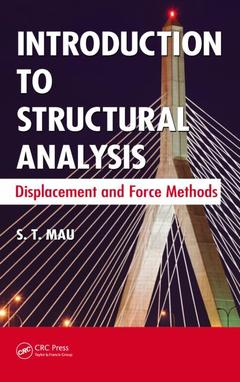Introduction to Structural Analysis Displacement and Force Methods
Auteur : Mau S. T.

Bridging the gap between what is traditionally taught in textbooks and what is actually practiced in engineering firms, Introduction to Structural Analysis: Displacement and Force Methods clearly explains the two fundamental methods of structural analysis: the displacement method and the force method. It also shows how these methods are applied, particularly to trusses, beams, and rigid frames.
Acknowledging the fact that virtually all computer structural analysis programs are based on the matrix displacement method of analysis, the text begins with the displacement method. A matrix operations tutorial is also included for review and self-learning. To minimize any conceptual difficulty readers may have, the displacement method is introduced with the plane truss analysis and the concept of nodal displacement.
The book then presents the force method of analysis for plane trusses to illustrate force equilibrium, deflection, statistical indeterminacy, and other concepts that help readers to better understand the behavior of a structure. It also extends the force method to beam and rigid frame analysis. Toward the end of the book, the displacement method reappears along with the moment distribution and slope-deflection methods in the context of beam and rigid frame analysis. Other topics covered include influence lines, non-prismatic members, composite structures, secondary stress analysis, and limits of linear and static structural analysis.
Integrating classical and modern methodologies, this book explains complicated analysis using simplified methods and numerous examples. It provides readers with an understanding of the underlying methodologies of finite element analysis and the practices used by professional structural engineers.
Truss Analysis: Matrix Displacement Method. Truss Analysis: Force Method—Part I. Truss Analysis: Force Method—Part II. Beam and Frame Analysis: Force Method—Part I. Beam and Frame Analysis: Force Method—Part II. Beam and Frame Analysis: Force Method—Part III. Beam and Frame Analysis: Displacement Method—Part I. Beam and Frame Analysis: Displacement Method—Part II. Influence Lines. Other Topics. Appendix A: Matrix Algebra Review. Appendix B: Supplementary Review Notes.
S.T. Mau, PhD, PE, is a professor in the Department of Civil Engineering and Applied Mechanics at California State University, Northridge. He was formerly Dean of Engineering at New Jersey Institute of Technology and California State University, Northridge, and department chair at National Taiwan University and University of Houston. He is also the co-author of a previous textbook, Elementary Theory of Structures, Fourth Edition (1995), and a recipient of the Moisseiff Award of the American Society of Civil Engineers.
Date de parution : 05-2012
Ouvrage de 336 p.
15.6x23.4 cm
Thème d’Introduction to Structural Analysis :
Mots-clés :
Member End Moments; Deflection Diagrams; Civil Engineering; Nodal Displacements; Matrix Displacement Method; Unit Load; Simplified Methods; Unit Load Method; Structural Analysis Textbook; Nodal Forces; Structural Analysis; Conjugate Beam; Beam And Rigid Frame Analysis; Member Elongation; Force Method; Moment Distribution Method; Redundant Force; Side Sway; Member Stiffness Matrix; Virtual Displacement; Equilibrium Equation; Consistent Deformations; Stiffness Matrix; Virtual Force; Member Force; Global Stiffness Matrix; Plane Truss; Virtual Unit Load; Dx EI; CS CS; Influence Line



